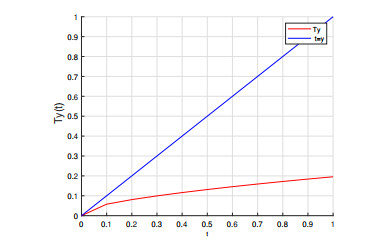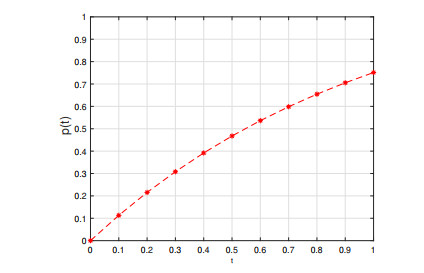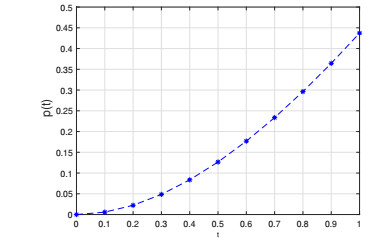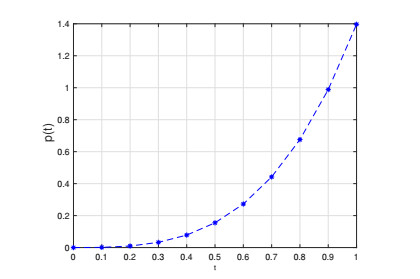1.
Introduction
The fractional differential equations have drawn much attention due to their applications in a number of fields such as physics, mechanics, chemistry, biology, economics, biophysics, etc, see [16,32]. Some physical phenomena such as the fractional oscillator equations and fractional Euler-Lagrange equations with mixed fractional derivatives can be found in [10,12,31]. Once a model of fractional differential equation for the real problem have been constructed, people faced the issue of how to solve this model. In many circumstances, finding the exact solution to the fractional differential equation is quite challenging. As a result, researchers must identify as many aspects of the problem's solution as possible. Is there a solution to the problem, for example? Is the solution unique if there is a one? Hence the study of existence and uniqueness solutions for fractional differential equations with initial and boundary conditions appealed many scientists and mathematicians [2,3,4,19,20,21,25,27,30]. Some existence results for fractional differential equations with integral boundary conditions can be found in [17,28,29]. Recently, the existence theorem for fractional differential equations involving mixed fractional derivatives have been studied by many authors [5,6,8]. More specifically, Abbas [1] proved the existence and uniqueness of solution for a boundary value problem of fractional differential equation of the form
where α∈(m−1,m],m≥2, and CDα,CDβ are the Caputo fractional derivatives. Alghamdi et al.[7] studied new existence and uniqueness results for three-point boundary value problem of sequential fractional differential equations given by
where CDβ is Caputo fractional derivative. Song et al. [34] used the coincidence degree theory while proving the existence of solutions of the following nonlinear mixed fractional differential equation with the integral boundary value problem:
where CDα1− and Dβ0+ are respectively the left Caputo fractional derivative and the right Riemann–Liouville fractional derivative. Sousa et al. [35] investigated the existence and uniqueness of mild and strong solutions of fractional semilinear evolution equations, by means of the Banach fixed point theorem and the Gronwall inequality. The notion of Ulam stability has been studied and expanded in many ways. There have been a number of articles published on this subject that have yielded a number of conclusions [11,23,24]. Ibrahim [18] examined Ulam stability for the Cauchy differential equation of fractional order in the unit disk. Chen et al. [13] studied the Ulam-Hyers stability of solutions for linear and nonlinear nabla fractional Caputo difference equations when 0<v≤1 on finite intervals. The linear case has the form
and the non-linear case has the form
Muniyappan and Rajan [26] discussed Hyers-Ulam and Hyers-Ulam-Rassias stability for the following fractional differential equation with boundary condition
where Dα is Caputo fractional derivative of order α. Dai et al. [14] researched the Ulam–Hyers and Ulam–Hyers–Rassias stability of nonlinear fractional differential equations with integral boundary condition which has the form
where Dα is Caputo derivative and Iβ0+(.) is the Riemann–Liouville fractional integral.
In this paper, we consider the nonlinear fractional differential equations wich has the form
with initial conditions
where f:J×R→R, 1<α≤2,0<β≤1, CDα is the Caputo fractional derivative, and RDβ is the Riemann fractional derivative. New existence and uniqueness results are obtained by driving the corresponding Green's function of problem (1.1) and (1.2) with the help of the Schauder theorem and Banach contraction principle. Furthermore, the Ulam–Hyers and Ulam–Hyers–Rassias stability for Eq (1.1) is briefly described. Finally, some examples are given to demonstrate the application of our main results.
2.
Preliminaries
Let us give some definitions and lemmas that are basic and needed at various places in this work.
Definition 2.1. [9] Let f be a function which is defined almost everywhere (a.e.) on [a,b], If α>0, then:
provided that this integral (Lebesgue) exists.
Definition 2.2. [22] The Riemann-Liouville fractional derivative oforder α>0 for a function function f:[0,∞)→R, is defined as
where n=[α]+1,[α] denotes the integer part of the real number α.
Definition 2.3. [32] For a continuous function f:[0,∞)→R, the Caputo derivative of fractional order α is defined as
provided that f(n) exists, where n=[α]+1,[α] denotes the integer part of the real number α.
Lemma 2.4. [32] Let f(t)∈L1[a,b] and α,β≥0. Then
Moreover, if f(t)∈C[a,b], then the above identity is true for all t∈[a,b].
Lemma 2.5. [9] Let α>0, n be the smallest integer n>α and let f(t)∈L(a,b). If taDα−1f exists and is absolutely continuous on [a,b], then a+aDα−if=ki exists for i=1,2,...,n; taDαf exists a.e. on [a,b], is in L(a,b) and
Furthermore, the inequality holds everywhere on (a,b], if in addition, f(t) is continuous on (a,b].
Lemma 2.6. [22] Let α>0. If we assume y∈C(0,1)∩L1(0,1), then the Caputo fractional differential equation
has the solution
where ci∈R,i=0,1,2,...,n−1, and n=[α]+1.
Lemma 2.7. [22] Let y∈C(0,1)∩L1(0,1) with fractional derivative of order α>0 that belongs to C(0,1)∩L1(0,1). Then
for ci∈R,i=0,1,2,...,n−1, where n is the smallest integer greater than or equal to α.
Lemma 2.8. [9,32] Let α, β∈R, β>−1. If t>a, then
Definition 2.9. [32] The two-parametric Mittag-Leffler function is defined as
Theorem 2.10. [15] (Arzela-Ascoli Theorem). If X is compact and f⊆C(X), then f totally is bounded if and only if f is bounded and equicontinuous.
Theorem 2.11. [15] (Schauder fixed point theorem). Let X be a Banach space and let M⊆X be nonempty, convex, and closed. If T:M→M is compact, then T has a fixed point
Theorem 2.12. [36] (Contraction mapping principle). Let M be a Banach space. If T:M→M is a contraction, thenT has a unique fixed point in M.
For the definitions of Ulam-Hyers stable and Ulam-Hyers-Rassias stable see [33].
Definition 2.13. The Eq (1.1) is Ulam-Hyers stable if there exists a real number cf>0 such that for each ε>0 and for each solution z∈C1(J,R) of the inequality
there exists a solution y∈C1(J,R) of Eq (1.1) with
Definition 2.14. The Eq (1.1) is Ulam-Hyers-Rassias stable with respect to φ∈C(J,R+) if there exists a real number cf>0 such that for each ε>0 and for each solution z∈C1(J,R) of the inequality
there exists a solution y∈C1(J,R) of Eq (1.1) with
Lemma 2.15. Let f∈C[0,1], y∈C1[0,1], then the initial value problem (1.1) and (1.2) has a solution
where G(t,s) is the Green's function described by
where
Proof. By applying the Lemma 2.5 and 2.7, we may reduce Eq (1.1) to an equivalent equation
Operate both sides of Eq (2.4) by operator D, we get
Then the solution of Eq (2.5) is
Using the initial conditions (1.2), we find that
Substituting the values of c1 and k1 in Eq (2.6), we have
The converse of the lemma follows from a direct computation. Hence, the proof is completed.
3.
Main results
In this section, we prove the existence and uniqueness of solution for the problem (1.1) and (1.2) in the Banach space C by applying Banach contraction principle and Schauder fixed point theorem.
Let C([0,1],R) denote the Banach space of all continuous functions from [0,1] into R with the norm defined by
To prove the main results, we need the following assumptions:
(H1) There exists a positive constants γ1,γ2 such that |f(t,y(t))|≤γ1+γ2|y(t)|, for each t∈J and all y∈R.
(H2) There exists a positive constant k such that |f(t,x(t))−f(t,y(t))|≤k|x(t)−y(t)|,
for each t∈J and all x,y∈R.
(H3) There exists an increasing function φ∈C(J,R+) and there exists νφ>0 such that for any t∈J, we have
For convenience, we define the following notations:
The existence result can be obtained by the Schauder fixed point theorem.
Theorem 3.1. Assume f:J×R→R is continuous and satisfies (H1). Then the problem (1.1) and (1.2) has a solution.
Proof. Consider an operator T defined on C(J) by
By the continuity of the functions G(t,s) and f(t,y(t)), we have Ty∈C(J) for any y∈C(J). We define the set Br={y(t)∈C(J,R):‖y‖≤r} and choose r≥γ1Λ1(1−γ2Λ1). First, we have to show that TBr⊆Br, for y∈Br. Now, consider
Then
and so
Therefore, we have
which implies that
Hence, TBr⊆Br.
Next, we need to prove that T is a completely continuous operator. For this purpose we fix,
Q=supt∈J|f(s,y(s))|, where y∈Br, and t,τ∈J with t<τ. Then
Therefore,
and so
Let t→τ, the right-hand side of the above inequality tends to zero. Thus, T is uniformly bounded and equicontinuous. Therefore by th Arzela-Ascoli implies that T is completely continuous. Hence, by Schauder's fixed point theorem, the problem (1.1) and (1.2) has a solution on C(J,R). Now, we use the contraction principle mapping to investigate uniqueness results for (1.1) and (1.2).
Theorem 3.2. Suppose that (H2) holds. If
where Λ2=(λ+e−λ−1)λ, then the problem (1.1) and (1.2) has a unique solution.
Proof. Let x,y∈C(J,R). Then
and so
Therefore,
Then
Hence
Using the condition (3.1), we conclude that T is a contraction mapping. Hence Banach contraction principle guarantees that T has a fixed point which is the unique solution of the problem (1.1) and (1.2). The proof is complete.
4.
Stability theorems
In this section, we study Ulam-Hyers and Ulam-Hyers-Rassias stability of our problem (1.1) and (1.2).
Theorem 4.1. Assume that f:J×R→R is a continuous function and (H2) holds with kμ<1. Then the problem (1.1) and (1.2) is Ulam-Hyers stable.
Proof. Let z(t)∈C(J,R) be a solution of the inequality (2.1), and there exists a solution y∈C(J,R) of Eq (1.1). Then, we have
From inequality (2.1), for each t∈J, we get
by (H2), for each t∈J, we obtain
Then from Eq (4.1) we conclude that
If cf=E1,α+β(−λ)1−kμ, then inequality
holds. Thus the problem (1.1) and (1.2) is Ulam-Hyers stable.
Theorem 4.2. Assume that f:J×R→R is a continuous function and (H2), (H3) holds with kμ<1. Then the problem (1.1) and (1.2) is Ulam-Hyers-Rassias stable.
Proof. Let z(t)∈C(J,R) be a solution of the inequality (2.2), and there exists a solution y∈C(J,R) of Eq (1.1). From inequality (2.2), for each t∈J, we have
by using the hypothesis (H2), for each t∈J, we get
Then the use of Eq (4.2) implies that
Set cf=νφ1−kμ. The inequality
holds. The problem (1.1) and (1.2) is Ulam-Hyers-Rassias stable.
5.
Examples
In this section, we give two examples to illustrate the usefulness of our main results.
Example 5.1. Consider the following fractional initial value problem:
Here, α=1.2, β=0.2, and λ=1. By Lipschitz condition, we obtain k=0.25. To estimate the contraction mapping, apply Theorem 3.2 to get kμ=0.1499975<1. This proves the problem (5.1) has a unique solution.
By Theorem 4.1, we have
which shows the problem (5.1) is Ulam-Hyers stable.
Now, to analyze the behavior of the operator T, one can see that |f(t,y(t))|≤0.2103677 and |Ty(t)|≤0.2103677ζ3, (see Figure 1).
Example 5.2. Consider the following fractional initial value problem:
Here, α=1.5,β=0.5,λ=1, and k=56. By a direct calculation, one can obtain that
kμ=0.298856<1. Then by Theorem 3.2, the problem (5.2) has a unique solution.
Furthermore, by Theorem 4.1, the problem (5.2) is Ulam-Hyers stable with
Now, to illustrate the obtained results for Ulam-Hyers and Ulam-Hyers-Rassias stability, we consider the following cases:
CaseI: We start by computing the value of p(t)=|z(t)−y(t)| for y=1. From the Eq (2.1), we have
Therefor, by Theorem 4.1, the problem (5.2) has a solution z satisfying
CaseII: We estimate the value p(t) for y=1 and φ(t)=t, from the Eq (2.2), we obtain ε=0.83333. By Theorem 4.2, the problem (5.2) is Ulam-Hyers-Rassias stable with
Now, we estimate the value p(t) for y=1 when the function φ(t)=et. The problem (5.2) is Ulam-Hyers-Rassias stable with
6.
Conclusions
In this research, we examined the solution of nonlinear fractional differential equations with integral initial conditions. By means of the Shauder fixed point theorem and contraction mapping principle, we proved the existence and uniqueness of solutions for a nonlinear problem. In addition, the Hyers-Ulam and Hyers-Ulam-Rassias stability of the problem (1.1) and (1.2) are studied. Lastly, we presented several examples to demonstrate the use of our main theorems.
Conflict of interest
The authors declare no conflict of interest.










 DownLoad:
DownLoad:






